Out of Sight and Out of Mind
Modern sanitation practices in the US were born in the waning years of the 19th century. Driven by a public health and nuisance abatement agenda and propelled by indescribable filth in the larger cities across the continent, these practices focused primarily on shielding individuals from their own garbage. Trash lay so thickly in the streets of cities like New York that it formed an impediment to effective transportation. The mandate of the municipal collection services and private haulers of the time was primarily to make the garbage go away and secondarily to produce some income with which to defray expenses for such services as street-sweeping. Initially, almost all the garbage was reused—sorted and recycled, fed to pigs, boiled and rendered for fertilizer, burned to generate steam, and even used for fill to “improve” real estate values.
But this general approach of simply making away with residential garbage and not burdening its producers with the details is not relevant to the challenges of our time. The secondary mandate concerning re-use went by the wayside after World War II, as economic abundance in general and cheap chemical fertilizers in particular obviated the need for traditional reuse practices. Now environmental exigences demand its return, even moving it up to the top of the list of our priorities. To do so effectively, we have to take another look at that other mandate, by which our trash is whisked out of sight and out of mind on collection day.
New Realities
The volume of our trash has swelled precipitously, and so has its toxic content. Incineration is expensive and attended by significant political liabilities. Landfilling, still the cheapest and politically least painful option, is associated with significant environmental burdens as well as huge deferred costs. These disadvantages are gradually making landfill less attractive, and so space is becoming a scarce commodity. Older landfills have been determined almost without exception unsafe in the last 20 or 30 years and have been closed at a much faster rate than new landfill is being created. Siting new landfill is extremely difficult, being fraught with environmental regulation and further hampered by popular aversion and NIMBY-ism. The practice of exporting garbage is gaining in popularity, but by the same token fewer and fewer states are comfortable with the idea importing “other people’s garbage.”
State and local governments are hard at work to reduce the amount of waste that ends up in landfill, at least within their own state. And this, of course, is where we come in–individual producers of truly astounding quantities of trash. The success of local waste reduction programs depends at least to a certain extent on our willingness to accept and pursue changes in behavior–more effective source separation and, perhaps more fundamentally, reductions in consumption.
Financial incentives and conveniences are universally acknowledged as necessary preconditions for the desired private-sphere behaviors. But the out-of-sight, out-of mind sanitation philosophy has also got to go. What’s needed is a concrete answer to the question of what happens to our trash, since it is ultimately the reason why our behaviors are due for a change.
The Plot Summary
In broad outline, the story of our garbage is this: Americans produce on average about 4.5lbs of household garbage per day, which adds up to an estimated 90,000lbs in one’s lifetime. About 85% or more of that garbage goes to landfill, where biodegradation is prevented as much as sanitary engineers can manage to call a halt to the natural influence of air and water. Intricate (but inadequate) collection systems attempt to capture methane and toxic runoff, while liners and caps insulate our castoffs from the agents of biodegration. One recent positive development is that, given the rise in oil prices, more and more landfills are being hitched to machinery that converts landfill gas to usable fuel. (More on this at Time Capsules)
The remainder of our trash is incinerated, also resulting in energy. Engineers attempt to scrub the harmful toxins out of the gases escaping the smoke stacks, while the environmental movement argues with the waste management lobby over how serious the impact of the matter that gets by them. New incineration technologies are under development, and their relative environmental impact is equally hotly debated.
For the most part, that summary is the best you can do when you ask what happens to our garbage. But just as the Cliff Notes don’t measure up to the masterpiece they describe, that summary isn’t nearly as effective as knowing the particulars of what actually happens with one’s very own trash.
The Real Story
Having attempted to locate my own lifetime production of garbage, I can report that between dusty archives and out-of-print books, you can get a really long way. These pages bear witness to a few of the places that harbor my ancient leftovers, so you might get a general sense of how I have personally (though unintentionally) helped to transform the world with my trash. Check out for instance:
– Another Mountain
– Following the Trail
– The Highest Point in Drenthe
– Weber’s Pit
Unfortunately, at this time, there are few shortcuts around the dusty archives. If you live in California, you can skip ahead and consult the Waste Stream Profiles maintained by the California Integrated Waste Management Board to find the destination of your trash for the last 10 years or so. However, be prepared to spend significant time poking around the database before you’ll pry the answer from its cold, stiff grasp. (In case you’re having trouble figuring out how to make the Profiles cough up your answer, you can consult these step-by-step instructions. I use the town of Antioch as an example. If you start counting once you visit the CIWMB’s website, then it takes about 50 steps to figure out what happens to Antioch’s garbage. Don’t be discouraged. It’s worth the effort.)
It would be great if every state offered this kind of information, no matter how shabby the interface, but I haven’t been able to find any other online resources like Calfiornia’s Waste Stream Profiles.
Another Way to Tell the Tale
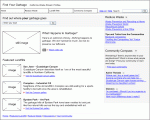 Since I make my living as (among other things) an interaction designer, I have naturally also been thinking about the kind of interface that might reveal the information in a more intuitive and engaging way. These preliminary sketches are known as “wireframes” and try to represent how a web page might work without including any look and feel. They exemplify the general design principles of knowledge, engagement, and identity, which I explain in more detail elsewhere.
Since I make my living as (among other things) an interaction designer, I have naturally also been thinking about the kind of interface that might reveal the information in a more intuitive and engaging way. These preliminary sketches are known as “wireframes” and try to represent how a web page might work without including any look and feel. They exemplify the general design principles of knowledge, engagement, and identity, which I explain in more detail elsewhere.
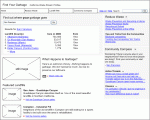 In short, the sketches are based on the notion that people need concrete and vivid information to nurture a motivation for change, that they need a local community in which to develop and elaborate such new behaviors collaboratively, and that they need a forum in which to develop a sense of identity that is grounded in more sustainable hopes and ideals than are offered by mainstream consumerism.
In short, the sketches are based on the notion that people need concrete and vivid information to nurture a motivation for change, that they need a local community in which to develop and elaborate such new behaviors collaboratively, and that they need a forum in which to develop a sense of identity that is grounded in more sustainable hopes and ideals than are offered by mainstream consumerism.
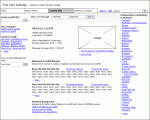 One really important piece would be to enable people to help document the places where their trash ends up–by uploading pictures and telling stories of times they might have gone to those landfills to dump off their outsize leftovers. No matter how low the landfill might rank in the hierarchy of desirable real estate, once it was beautiful wetland or quiet canyon or peaceful meadow, and it’s a part of who we are, all of us collectively.
One really important piece would be to enable people to help document the places where their trash ends up–by uploading pictures and telling stories of times they might have gone to those landfills to dump off their outsize leftovers. No matter how low the landfill might rank in the hierarchy of desirable real estate, once it was beautiful wetland or quiet canyon or peaceful meadow, and it’s a part of who we are, all of us collectively.
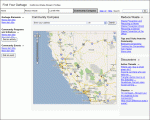 Social networking tools can be helpful in identifying and strengthening the local communities that would participate in the process and embark on the journey to a sustainable identity–by which I mean a sense of identity that doesn’t depend on possessions, but rather on self-enrichment, meaningful relationships with other people, and a role in a community.
Social networking tools can be helpful in identifying and strengthening the local communities that would participate in the process and embark on the journey to a sustainable identity–by which I mean a sense of identity that doesn’t depend on possessions, but rather on self-enrichment, meaningful relationships with other people, and a role in a community.
When I think of social networking tools in this context, they don’t present themselves primarily as a way for people to communicate regardless of geography, but rather a set of tools that help people navigate their local geography, learn about the place, find other people to interact with (preferably face to face), and think about themselves in such a context. It would be a way not to abstract from geography, but to get closer to it.
The Meta-Narrative
Of course you might ask why I worry about the relatively manageable problem of garbage in the face of impending or perhaps already unfolding catastrophic climate change. It is a question I have asked myself. I believe that two considerations make garbage relevant to the larger challenges that confront us:
– Garbage is the most concrete and visible consequence of an unsustainable consumerist lifestyle. People who have trouble connecting to the issue of climate change tell me that they do feel strongly about finding a way to tackle the issue of garbage.
– The behavior changes–especially a questioning and subversion of the dominant ideology of unbridled consumption–which would make a significant dent in our trash production are the same changes that are necessary to alter the course of our future.
If we were to achieve such changes, we would not only stand a better chance of surviving in the long term, I believe, but of being happy in the here and now.
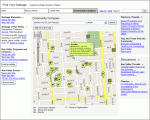
Thanks for your personal marvelous posting! I actually enjoyed
reading it, you will be a great author.I will ensure that I bookmark your blog and definitely will come back sometime soon.
I want to encourage one to continue your
great job, have a nice morning!